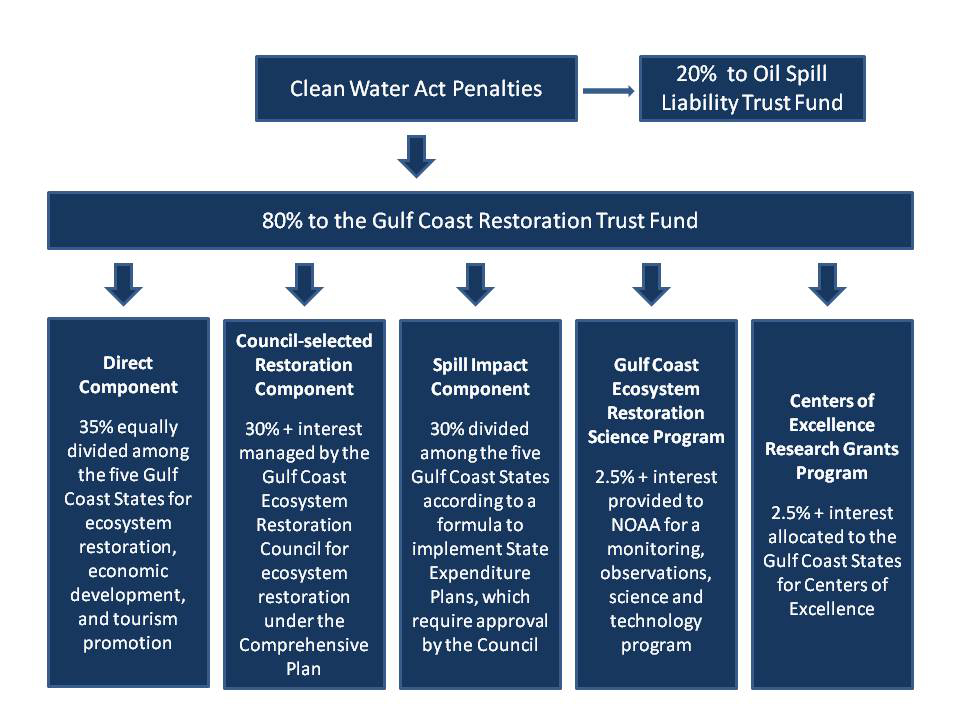Restore 101
Resources And Ecosystem Sustainability, Tourist Opportunities, And Revived Economies Of The Gulf Coast States Act
In July 2012, Congress passed the Resources and Ecosystems Sustainability, Tourist Opportunities, and Revived Economies of the Gulf Coast States Act (RESTORE Act) in response to the Deepwater Horizon oil spill. The RESTORE Act dedicates 80 percent of all administrative and civil penalties related to the Deepwater Horizon spill to a Gulf Coast Restoration Trust Fund and outlines a structure by which the funds can be utilized to restore and protect the natural resources, ecosystems, fisheries, marine and wildlife habitats, beaches, coastal wetlands, and economy of the Gulf Coast region. The U.S. Department of the Treasury is responsible for issuing compliance and auditing procedures for the entire Act and procedures for two grant programs administered by Treasury. On February 12, 2016, the RESTORE Act rule published by Treasury on December 14, 2015, became effective. This rule combines the comprehensive interim final rule and the Louisiana Parish Allocation Formula interim final rule, both of which were effective on October 14, 2014. This final rule takes into account the public comments that Treasury received regarding the comprehensive interim final rule. The preamble and the final rule include minor changes in response to public comments and to address necessary technical corrections. Under the Act, Treasury will administer two grant programs, called the Direct Component and the Centers of Excellence Research Grants Program. The amounts currently available to eligible grant recipients under these programs, as well as those currently available under other RESTORE Act programs, may be found here. Treasury plans to update this information periodically. The amounts available will change as new deposits are made into the Trust Fund, interest from investments is credited, and amounts are withdrawn by grant recipients for eligible programs, projects, and activities under the Act.
The RESTORE Act also established the Gulf Coast Ecosystem Restoration Council (Council). The Council is comprised of the governor’s of the Alabama, Florida, Louisiana, Mississippi, and Texas, as well as the U.S. Department of Agriculture, U.S. Department of the Army, U.S. Department of Commerce, U.S. Environmental Protection Agency, U.S. Department of Homeland Security, and the U.S. Department of the Interior. The Council will administer two grant programs under the Act, the Council-Selected Restoration Component and the Oil Spill Impact Component.
The RESTORE Act sets forth the following framework for allocation of the Trust Fund:
- 35 percent equally divided among the five States for ecological restoration, economic development, and tourism promotion;
- 30 percent plus interest managed by the Council for ecosystem restoration under the Comprehensive Plan;
- 30 percent divided among the States according to a formula to implement State expenditure plans, which require approval of the Council;
- 2.5 percent plus interest for the Gulf Coast Ecosystem Restoration Science, Observation, Monitoring and Technology Program within the Department of Commerce’s National Oceanic and Atmospheric Administration (NOAA); and
- 2.5 percent plus interest allocated to the States for Centers of Excellence Research grants, which will each focus on science, technology, and monitoring related to Gulf restoration.


